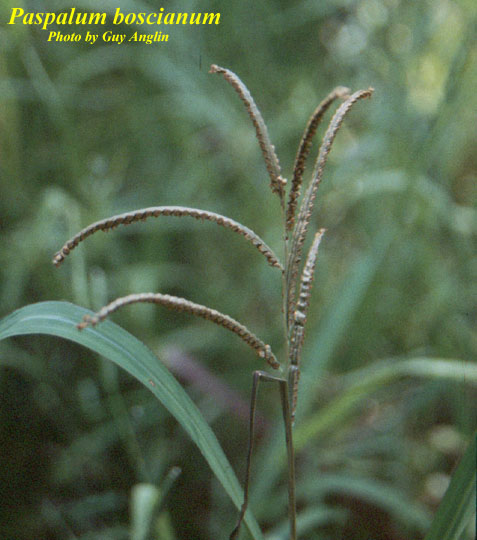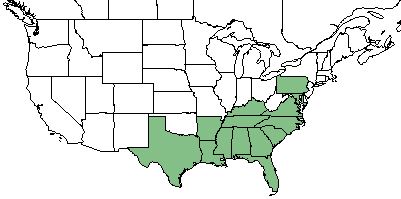Difference between revisions of "Paspalum boscianum"
HaleighJoM (talk | contribs) (→Ecology) |
|||
| (4 intermediate revisions by 3 users not shown) | |||
| Line 1: | Line 1: | ||
{{italic title}} | {{italic title}} | ||
| − | Common name: bull crowngrass <ref name= "USDA Plant Database"/>, bull paspalum <ref name= "Weakley 2015"/> | + | Common name: bull crowngrass<ref name= "USDA Plant Database"/>, bull paspalum<ref name= "Weakley 2015"/> |
<!-- Get the taxonomy information from the NRCS Plants database --> | <!-- Get the taxonomy information from the NRCS Plants database --> | ||
{{taxobox | {{taxobox | ||
| Line 19: | Line 19: | ||
}} | }} | ||
==Taxonomic Notes== | ==Taxonomic Notes== | ||
| − | Synonyms: none | + | Synonyms: none.<ref name="weakley">Weakley, A.S. 2015. Flora of the southern and mid-atlantic states. Working Draft of 21 May 2015. University of North Carolina at Chapel Hill, Chapel Hill, North Carolina.</ref> |
| − | Varieties: none | + | Varieties: none.<ref name="weakley">Weakley, A.S. 2015. Flora of the southern and mid-atlantic states. Working Draft of 21 May 2015. University of North Carolina at Chapel Hill, Chapel Hill, North Carolina.</ref> |
==Description== | ==Description== | ||
<!-- Basic life history facts such as annual/perrenial, monoecious/dioecious, root morphology, seed type, etc. --> | <!-- Basic life history facts such as annual/perrenial, monoecious/dioecious, root morphology, seed type, etc. --> | ||
| − | ''P. boscianum'' is | + | ''P. boscianum'' is a coarse annual graminoid of the ''Poaceae'' family native to North America and Puerto Rico.<ref name= "USDA Plant Database"> USDA Plant Database [https://plants.usda.gov/core/profile?symbol=PABO3 https://plants.usda.gov/core/profile?symbol=PABO3] </ref> Its geniculate culms 3-9 dm tall with glabrous nodes and internodes. The blades are 25 cm long, 4-11 mm wide, and glabrous, with scarious margins. Ligules are 1-2 mm long. The axes of panicle branches broadly winged and the wings about as wide as the central portion. The plant has 2-11 racemes that are racemose, ascending, and 1.5-9 cm long. The suborbicular spikelets grow in 4 rows, reaching 2-1.2 mm broad.<ref name="radford">Radford, A. E., Ahles, H. E., & Bell, C. R. (1968). Manual of the vascular flora of the Carolinas. Chapel Hill: University of North Carolina Press.</ref> |
==Distribution== | ==Distribution== | ||
| − | ''P. boscianum'' | + | ''P. boscianum'' ranges from Maryland to Kentucky, and Texas, south through tropical America.<ref name="radford">Radford, A. E., Ahles, H. E., & Bell, C. R. (1968). Manual of the vascular flora of the Carolinas. Chapel Hill: University of North Carolina Press.</ref> |
==Ecology== | ==Ecology== | ||
===Habitat=== <!--Natural communities, human disturbed habitats, topography, hydrology, soils, light, fire regime requirements for removal of competition, etc.--> | ===Habitat=== <!--Natural communities, human disturbed habitats, topography, hydrology, soils, light, fire regime requirements for removal of competition, etc.--> | ||
| − | ''P. boscianum'' proliferates in marshes, cypress domes, low fields, and ditches. <ref name= "Weakley 2015"> Weakley, A. S. (2015). Flora of the Southern and Mid-Atlantic States. Chapel Hill, NC, University of North Carolina Herbarium. </ref> Specimens have been collected from drying loamy sands of secondary woods, burned pine-oak woodland, pond in pine barrens, dried pond bottom, stream bank, ditch bordering savanna, swale in slashpine, coastal hammock pond, shore of farm pond, swampy woods, and cypress pond. <ref name = "FSU herbarium"> URL: http://herbarium.bio.fsu.edu. Last accessed: June 2018. Collectors: Loran C. Anderson, A.H. Curtiss, R.K. Godfrey, R.A. Pursell, R.Kral, S. Mcdaniel, Andre Clewell, R.A. Norris, R. Komarek, Richard R. Clinebell II. States and counties: Florida (Leon, Baker, Jackson, Gadsden, Calhoun, Palm Beach, Franklin, Gulf, Gadsden, Jackson, Santa Rosa, Hernando, Escambia, Madison, Duval, Wakulla) Georgia (Thomas, Seminole)</ref> | + | ''P. boscianum'' proliferates in marshes, cypress domes, low fields, and ditches.<ref name= "Weakley 2015"> Weakley, A. S. (2015). Flora of the Southern and Mid-Atlantic States. Chapel Hill, NC, University of North Carolina Herbarium. </ref> Specimens have been collected from drying loamy sands of secondary woods, burned pine-oak woodland, pond in pine barrens, dried pond bottom, stream bank, ditch bordering savanna, swale in slashpine, coastal hammock pond, shore of farm pond, swampy woods, and cypress pond.<ref name = "FSU herbarium"> URL: http://herbarium.bio.fsu.edu. Last accessed: June 2018. Collectors: Loran C. Anderson, A.H. Curtiss, R.K. Godfrey, R.A. Pursell, R.Kral, S. Mcdaniel, Andre Clewell, R.A. Norris, R. Komarek, Richard R. Clinebell II. States and counties: Florida (Leon, Baker, Jackson, Gadsden, Calhoun, Palm Beach, Franklin, Gulf, Gadsden, Jackson, Santa Rosa, Hernando, Escambia, Madison, Duval, Wakulla) Georgia (Thomas, Seminole)</ref> |
| − | + | ===Phenology=== <!--Timing off flowering, fruiting, seed dispersal, and environmental triggers. Cite PanFlora website if appropriate: http://www.gilnelson.com/PanFlora/ --> | |
| + | This species flowers from July through October.<ref name="weakley">Weakley, A.S. 2015. Flora of the southern and mid-atlantic states. Working Draft of 21 May 2015. University of North Carolina at Chapel Hill, Chapel Hill, North Carolina.</ref> | ||
<!--===Seed dispersal===--> | <!--===Seed dispersal===--> | ||
<!--===Seed bank and germination===--> | <!--===Seed bank and germination===--> | ||
| − | + | ===Fire ecology=== <!--Fire tolerance, fire dependence, adaptive fire responses--> | |
| + | Populations of ''Paspalum boscianum'' have been known to persist through repeated annual burning.<ref>Platt, W.J., R. Carter, G. Nelson, W. Baker, S. Hermann, J. Kane, L. Anderson, M. Smith, K. Robertson. 2021. Unpublished species list of Wade Tract old-growth longleaf pine savanna, Thomasville, Georgia.</ref> | ||
<!--===Pollination===--> | <!--===Pollination===--> | ||
| − | <!--=== | + | <!--===Herbivory and toxicology===--> <!--Common herbivores, granivory, insect hosting, poisonous chemicals, allelopathy, etc--> |
| − | <!--==Diseases and parasites==--> | + | <!--===Diseases and parasites===--> |
| − | ==Conservation and | + | ==Conservation, cultivation, and restoration== |
| − | ''P. boscianum'' is listed as a species of special concern by the Kentucky State Nature Preserves Commission. <ref name= "USDA Plant Database"/> | + | ''P. boscianum'' is listed as a species of special concern by the Kentucky State Nature Preserves Commission.<ref name= "USDA Plant Database"/> |
| − | == | + | ==Cultural use== |
==Photo Gallery== | ==Photo Gallery== | ||
<gallery widths=180px> | <gallery widths=180px> | ||
</gallery> | </gallery> | ||
==References and notes== | ==References and notes== | ||
Latest revision as of 12:08, 15 July 2022
Common name: bull crowngrass[1], bull paspalum[2]
| Paspalum boscianum | |
|---|---|

| |
| Photo by Guy Anglin hosted at the Atlas of Florida Plants | |
| Scientific classification | |
| Kingdom: | Plantae |
| Division: | Magnoliophyta - Flowering plants |
| Class: | Liliopsida – Monocotyledons |
| Order: | Poales |
| Family: | Poaceae |
| Genus: | Paspalum |
| Species: | P. boscianum |
| Binomial name | |
| Paspalum boscianum Fluegge | |

| |
| Natural range of Paspalum boscianum from USDA NRCS Plants Database. | |
Contents
Taxonomic Notes
Synonyms: none.[3]
Varieties: none.[3]
Description
P. boscianum is a coarse annual graminoid of the Poaceae family native to North America and Puerto Rico.[1] Its geniculate culms 3-9 dm tall with glabrous nodes and internodes. The blades are 25 cm long, 4-11 mm wide, and glabrous, with scarious margins. Ligules are 1-2 mm long. The axes of panicle branches broadly winged and the wings about as wide as the central portion. The plant has 2-11 racemes that are racemose, ascending, and 1.5-9 cm long. The suborbicular spikelets grow in 4 rows, reaching 2-1.2 mm broad.[4]
Distribution
P. boscianum ranges from Maryland to Kentucky, and Texas, south through tropical America.[4]
Ecology
Habitat
P. boscianum proliferates in marshes, cypress domes, low fields, and ditches.[2] Specimens have been collected from drying loamy sands of secondary woods, burned pine-oak woodland, pond in pine barrens, dried pond bottom, stream bank, ditch bordering savanna, swale in slashpine, coastal hammock pond, shore of farm pond, swampy woods, and cypress pond.[5]
Phenology
This species flowers from July through October.[3]
Fire ecology
Populations of Paspalum boscianum have been known to persist through repeated annual burning.[6]
Conservation, cultivation, and restoration
P. boscianum is listed as a species of special concern by the Kentucky State Nature Preserves Commission.[1]
Cultural use
Photo Gallery
References and notes
- ↑ 1.0 1.1 1.2 USDA Plant Database https://plants.usda.gov/core/profile?symbol=PABO3
- ↑ 2.0 2.1 Weakley, A. S. (2015). Flora of the Southern and Mid-Atlantic States. Chapel Hill, NC, University of North Carolina Herbarium.
- ↑ 3.0 3.1 3.2 Weakley, A.S. 2015. Flora of the southern and mid-atlantic states. Working Draft of 21 May 2015. University of North Carolina at Chapel Hill, Chapel Hill, North Carolina.
- ↑ 4.0 4.1 Radford, A. E., Ahles, H. E., & Bell, C. R. (1968). Manual of the vascular flora of the Carolinas. Chapel Hill: University of North Carolina Press.
- ↑ URL: http://herbarium.bio.fsu.edu. Last accessed: June 2018. Collectors: Loran C. Anderson, A.H. Curtiss, R.K. Godfrey, R.A. Pursell, R.Kral, S. Mcdaniel, Andre Clewell, R.A. Norris, R. Komarek, Richard R. Clinebell II. States and counties: Florida (Leon, Baker, Jackson, Gadsden, Calhoun, Palm Beach, Franklin, Gulf, Gadsden, Jackson, Santa Rosa, Hernando, Escambia, Madison, Duval, Wakulla) Georgia (Thomas, Seminole)
- ↑ Platt, W.J., R. Carter, G. Nelson, W. Baker, S. Hermann, J. Kane, L. Anderson, M. Smith, K. Robertson. 2021. Unpublished species list of Wade Tract old-growth longleaf pine savanna, Thomasville, Georgia.